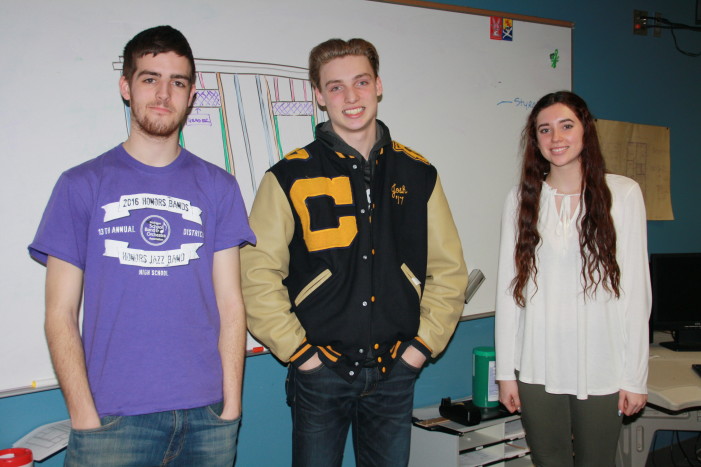From left are engineering students, senior Will Ephlin, senior Josh Knotts, and junior Trinity Roodbeen. Photo by Jessica Steeley
BY JESSICA STEELEY
Clarkston News Staff Writer
For Clarkston students interested in engineering, the Engineering and Design Technology pathway in career tech offers career skills and software knowledge.
Pathway teacher Laura Kalinowski has a variety of classes, including mechanical engineering, architecture, civil engineering and engineering graphics.
Her classes teach students how to use CAD and 3-D CAD, make blueprints, properly construct a house, design a space, etc.
“A lot of the same topics that we learn in our class can be directly being learned over at courses like U of M, or at Lawrence Tech where they’re teaching their students about things like beam loading or heat loss and gain,” Kalinowski said.
Many of her students go into mechanical engineering with a degree from a four-year university, but the skills her classes teach allow students to get good jobs, such as a CAD operator, with an apprenticeship, internship, or associate’s degree.
“I have a student right now that’s going to get an internship because of the CAD skills he’s learned in the class,” she said. “He’ll be basically transferring hand-drawn drawings into CAD drawings and they get those skills now to be able to do that.”
Senior Josh Knotts, who has taken several engineering courses including an independent study, is interested in design and mechanical engineering and thinks the classes will be applicable to the field.
“The engineering classes are kind of teaching you what to expect in the field of work, what you think you might do and kind of like getting you used to the programs and the software you might use in the future,” Knotts said.
Outside of the software, Kalinowski said the class also teaches students problem solving, team and group work and communicating professionally.
“Often they’ll come back and see me and let me know how the class really prepared them for what they were learning at their college level, or even at their internships,” she said. “They’ve just told me how it has translated into their everyday work experiences, the working in teams and in groups and how to work in a business setting and hit those deadlines.”
Kalinowski creates projects to allow her students to think outside of the classroom while in her engineering classes. Mechanical engineering students make blueprints to send to manufactures, architecture teaches students to be conscientious about sustainability and green architecture, and her engineering graphics students pair with another student in the school who has fine motor issues and designs a toy to help with that.
Will Ephlin, a senior who just learned about the engineering classes this year, found he enjoyed the real-world applications his civil engineering classes taught.
“The math we do in here is just addition and multiplication but it’s how we use it, is so much harder than any of the stuff that was in all the calculus classes,” Ephlin said. “It has a purpose.”
Junior Trinity Roodbeen wants to study mechanical engineering and said her engineering classes are more useful than regular core classes.
“Math is just kind of like ‘Oh, it’s math,’ and everyone’s always like ‘when am I ever going to use this?’” Roodbeen said. “But then you find out how you’re going to have to use it if you want to become an engineer, you get a taste of it.”

